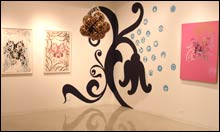 Recently I found myself aboard the Air Chair, a padded seat atop what looks like a riding lawnmower, at the Museum of Science’s “Star Wars: Where Science Meets Imagination” exhibit. I pushed a button and the contraption hovered an inch or so off the floor. I spun the steering wheel and a fan behind me nudged the thing a foot to the right or a foot to the left. It was part of a show of Star Wars props and real-world gadgets assembled to demonstrate the science behind the movie’s fantasies and “current research that may lead to real-life versions of these technologies” while also encouraging one to imagine how rad it would be to pilot Luke Skywalker’s X-34 landspeeder. I tried to imagine myself skimming over the scorched dunes of Tatooine but was distracted by the thought that I was a grown man keeping little kids from their turn aboard the Barcalounger of the Future.
Recently I found myself aboard the Air Chair, a padded seat atop what looks like a riding lawnmower, at the Museum of Science’s “Star Wars: Where Science Meets Imagination” exhibit. I pushed a button and the contraption hovered an inch or so off the floor. I spun the steering wheel and a fan behind me nudged the thing a foot to the right or a foot to the left. It was part of a show of Star Wars props and real-world gadgets assembled to demonstrate the science behind the movie’s fantasies and “current research that may lead to real-life versions of these technologies” while also encouraging one to imagine how rad it would be to pilot Luke Skywalker’s X-34 landspeeder. I tried to imagine myself skimming over the scorched dunes of Tatooine but was distracted by the thought that I was a grown man keeping little kids from their turn aboard the Barcalounger of the Future.
I hadn’t gone there just to make tots cry, though; I was on a serious intellectual quest. For some time I’d been thinking that today’s avant-garde art isn’t postmodern anymore but something in and of itself. I suspected this new thing had something to do with all the flat-screen televisions mushrooming from gallery walls, but I couldn’t put my finger on it. Then I attended the opening of Ryan McGinness’s “Mildly Subversive” at Montserrat College of Art (23 Essex Street in Beverly, through April 5). It pointed me toward a unified theory of contemporary art that I proudly dubbed “The New Star Wars Paradigm.” And that led me to the Museum of Science.

McGinness samples the stick figures of flashing walk signs and Heimlich-maneuver diagrams and product-assembly instructions and invents his own mutant versions. Then the 34-year-old New Yorker polishes them in his computer and converts them into screenprints or vinyl cutouts that he mixes and matches on linen, paper, skateboard decks, T-shirts, soccer balls. Hung from the ceiling, arranged in vitrines, displayed on mannequins, stuck on walls, his art gives the gallery the feel of a hipster boutique that doubles as a shrine to its creator. He’s another artist playing along the ever vaguer line between fine art and commercial culture, but his getting down and dirty with “the street” is mostly show. This is Fine Art, with moves ripped straight from the Duchamp-Warhol playbook. McGinness is saying something about the collapse of meaning in the chaos of signs that is America (not exactly a news flash) while wanting to define your entire experience of the world by making it his world.
Often this sort of superflat iconography feels like bimbo gift wrap, but many of McGinness’s ornate products are subtle and beautiful, especially when ghosts of images bleed through his layers of signs. He leaves cute tidy drips to hint at his improvisation. And a weird perceptual thing happened to me at Montserrat: my eyes raked in the symbols, as if they were reading letters, and then dashed on, looking to the wall or the next painting. If McGinness’s work is more than pretty decoration, I suspect this ADD paradox is where the more is.
The next day, I was thinking again about the other problem I was having, the problem everyone has been having: how to talk about today’s art. I recalled how McGinness’s work had looked as if some robot had made it, and I concluded that 21st-century avant-garde art is addressing our mad dash toward technological perfection and absolute control. Avant-garde art of the early 20th century was similarly concerned, but the new part of the equation is September 11 and our ongoing “War on Terror.” Our feelings about the promise of iPods and stem cells and Roomba vacuum cleaners are mixed up in the failure of US technological speed and “supremacy” to rout the human improvisation of al-Qaeda and the insurgents in Iraq.
I call this the New Star Wars Paradigm because it seems that today’s avant-garde artists engage these matters by siding either with the Empire or with, if not al-Qaeda, at least the Rebellion — and choosing the Rebellion is an implicit critique of Empire issues and styles. At the Museum of Science I mulled over the details. It’s the Empire of Darth Vader (bionic man), his Stormtroopers (biotech clones), and the Death Star (supreme control through technology) versus the Rebellion of Han Solo (scrappy flawed humanity), Chewbacca (harmony with nature), and their jury-rigged hot rod Millennium Falcon (recycling and adapting technology for personal use). These categories don’t necessarily confer æsthetic or political value. Some estimable Empire artists: Gregory Crewdson, Damien Hirst, Tony Oursler, Paul Pfeiffer, Bill Viola. Some Rebellion artists: John Currin, Mike Kelley, Dana Schutz, Kiki Smith, Kara Walker. The patron saint of Empire art? Andy Warhol. The patron saint of the Rebellion? Philip Guston.